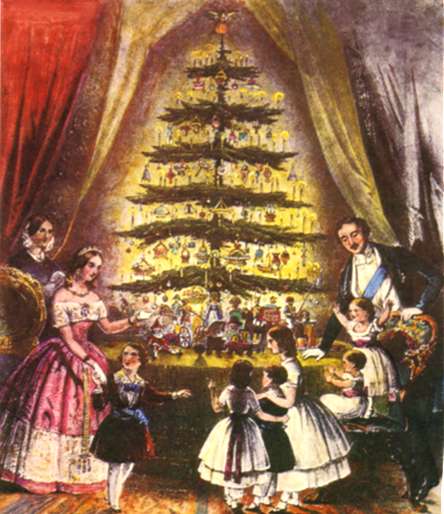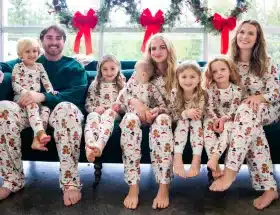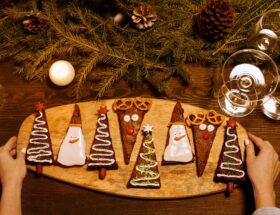By Pauline Weston Thomas for Fashion-Era.com

Table of Content
- Introduction to Christmas Tradition
- Christmas Comment
- Victorian Christmas Tree History
- Christmas Tree at Windsor Castle
- 'O Christmas Tree' Carol
- Early Christmas Tree Decoration
- Prince Albert in 1841
- Christmas Trees in the 20Th Century
- Fake Christmas Trees
- Christmas Trees in the Past Twenty Years
- Candles and Lights on the Xmas Tree
- Christmas Trees and Decoration in the Past Twenty Years
Introduction to Christmas Tradition
Fashion-era is about history, and the way we have dressed past and present and how society lives and changes. It seems appropriate then to look at Christmas celebratory traditions where traditional and modern customs and dressing up to complement the occasion, go hand in hand.
In this section I am still developing I shall be looking at the history of the Traditional Christmas and how we can recreate some of those simple ideas that bring a little memory making back into our lives. I'll be taking a look at Christmas cards, Christmas crackers, evergreen decorations and some crafts; some favourite Christmas recipes and words from carols and prose that mean Christmas to me. In addition I shall look at some fashion related items and beauty products that fashion-era visitors might like to use to pamper themselves with for the festivities.
Christmas Comment
Despite the fact that there are more gourmet delights available to eat, more consumer goods to buy and be given, many yearn only for the nostalgia of Christmases past as conjured up by films and literature. Consequently, the mid to late Victorian themed Christmas or the opulent extravagant Xmas, is the one that people attempt to recreate today.
Christmas is not mentioned in the Bible as a celebration in the way that Easter is. This is due in part because no one really knows when the birth of Jesus Christ occurred, not even the exact year let alone a day of a particular month. The calendar changes introduced by the Romans and other bodies means that the date is lost in antiquity. The Greek word for Christ is Xristos and so using the word Xmas along with Christmas became usual by 1500. In this section, I use both versions of the word happily.
However, Christmas traditions as we know them today owes much of it origins to the Victorians and the Victorian Christmas tree.
Events, calculations and pagan origins, prior to this date are well covered elsewhere on the web, but I prefer to look at Christmas traditions in the past 200 years from a fashion-era point of view. Various books already provide a detailed account of the origins of decorating and lighting trees to celebrate winter festivals from pagan times of old. This is a fairly modern history of the Christmas tree since about 1800. Read about more Christmas traditions on other pages.
Modern Christmas Tree History

Traditional German Carol
Today shared community Christmas trees are a common sight in many public buildings, shops, streets and churches.
These days many who celebrate Christmas have a tree both inside their home and also outdoors. Affluence amid westerners has increased over the past 20 years and many homes now have several trees all decorated with garlands of fairy lights or more recently, optic tips that shimmer and glow with movement.
O Christmas Tree (O Tannenbaum)
O Christmas Tree, O Christmas Tree
How lovely are your branches.
In summer sun and winter snow,
A dress of green you always show.
O Christmas tree, O Christmas tree,
How lovely are your branches.
O Christmas tree, O Christmas tree,
With happiness we greet you
When decked with candles once a year,
You fill our hearts with yuletide cheer.
O Christmas tree, O Christmas tree,
With happiness we greet you
O Tannenbaum, O Tannenbaum, wie treu sind deine Blätter.
O Tannenbaum, O Tannenbaum, wie treu sind deine Blätter.
Du grünst nicht nur zur Sommerzeit, nein auch im Winter, wenn es schneit.
O Tannenbaum, O Tannenbaum, wie treu sind deine Blätter.
Early Christmas Tree Decoration
In Britain the use of a celebratory Christmas tree as we know it today began in the 19th century. In the Victorian era the Norway fir tree was an important part of the Christmas celebration and was a focus for the exchange of small gifts. The tree was hung with small toys, cakes, sweetmeats and ribboned bags of sweets like sugared almonds or other bonbons.
After 1865 branches of trees were occasionally adorned with glass trinkets and silver wire ornaments a tradition that followed their German origin where many were obtained. The use of imported German glass ornaments was a custom in wealthier houses and these soon became a status symbol. But by 1880 Woolworth's sold commercially produced Xmas tree ornaments.
Another German decoration was Tinsel. Since the early 17th century real wafer thin silver tinsel was made for decorative purposes using a special machine and a variation of this tinsel product was used until the 1950s on Xmas trees. Tinsel from the 50s felt different from modern day lighter weight lametta tinsel, which does not have the drape of old tinsel, with a silver/pewter content. The modern version is made of aluminium foil sandwiched between two layers clear plastic.
Hours were spent by the young Victorian ladies of the house making small decorations from twists of coloured and decorated paper shaped into horned cornucopias ready to be filled with stuffed dates or other delights. With bits of silk and feathers they made pouches and draw purses to hold sugared fruits and almonds.
With silk thread they used macramé and lace skills to make tassels or lace snowflake style doilies, which they soaked in a dense sugar solution that enabled the doilies to be shaped and dried into decorative forms. Cotton wool was used to make little snowmen or wispy angels. Finally the very largest of gifts were placed under the tree and this was a focus for a cheerful and warm festive room.
We must give credit to Prince Albert for popularizing Christmas tree decoration in Britain. The tree as a festive focus was taken up by the nation at a time when Queen Victoria was at the height of her popularity. Yet as early as 1800 Queen Charlotte had made a present surrounded candle lit tree the spotlight of her Christmas celebrations.
Prince Albert in 1841
Later, following the German custom of his homeland, Prince Albert in 1841 had set up a tree at Windsor Castle. By 1848, The Illustrated London News published the a famous illustration of the 'Christmas Tree at Windsor Castle.' Later this picture was modified and reprinted in Godey's in the American market. Variations of the modified picture set a standard for how a tree might be expected to look.
This printed paper took the custom to wealthy and to the masses mainly through literature of the day. It soon began to replace another custom of a decorated kissing bough. A kissing bough was a mixed piece of greenery including mistletoe, evergreens, candles, apples and cinnamon sticks and these are now often created from either fresh greenery of artificial greenery today.
In 1854 a big Christmas tree was set down on the site of the 1851 Great Exhibition. As the custom for using decorated trees grew, demand increased annually and by the 1880s in the London area among wealthy families the demand was so great that nurseries had to ensure that they had a ready supply of trees.
Famous spots for public Xmas trees include London's Trafalgar Square, which annually displays a large Norwegian fir spruce tree so large it is usually about 60 years or more old and requires 500+ lights. Since 1945 these trees have been a gift of the city of Oslo in Norway as a Thank you to the British people for their help in World War II. Since 1982 a free tree from the British Christmas Tree Growers' Association has been placed in Downing Street near the Prime Minister's home of No.10.
North America had been ahead of the British in using Christmas trees.
During the war of Independence German mercenaries in the USA introduced the custom and so by the 1830s using trees as a custom at Christmas spread throughout the States. Americans favour Douglas fir trees and the slow shedding native spruce called Sitka spruce. By the mid Victorian era New York sold trees everywhere and by the 1890s the tree was a universal feature of American Christmases. Since 1912 Madison Square in New York have had a public tree that entrances all comers.
Christmas Trees in the 20th Century
In America, Addis made fake trees produced as a sideline of the well known brush company. That was in the early C20th , but as a British fashion, fakes did not really take on until the 1950s. In the UK there was a fashionable rage in the 1920s for feather trees. By the 1930s natural trees returned in the UK, bedecked with angels, baubles and bells.
I have read on the internet that cutting down trees for Christmas was forbidden during the Second World War and a claim that trees were impossible to find in South Wales. Not so. Three 87, 85 and 80 year old relatives all still living in South Wales insist that they never went without a Christmas tree and that they simply went to fields or woods nearby and cut a small tree down for the event. It was not an unpatriotic action, just a country reality in the same way that they hunted for rabbits and grew vegetables in their gardens.
Likewise, they never went without a Christmas cake and saved treasured food rations specially for the special celebration cake. They used carefully packed away pre-war decorations and turned their hand to using cardboard milk tops and raffia to make colourful home made Xmas tree decorations when silvered German glass baubles broke.
Fake Christmas Trees
Even though the fold down fake tree arrived in UK, forests planted with quick growing firs meant that the natural tree of the 1950s was a feature again. Then the tree that reached the ceiling was the popular one. Within a decade newer housing with much lower room heights of 8 foot or less meant that 3 to 5 foot trees became very common again and were often placed on sideboards. Later they were used as additional trees in other rooms.
Along with the fake tree new decorations emerged after 1960, mostly based on modern plastics and shiny synthetic yarns. Styrofoam balls were covered in silk threads and sequins and many of these items came through channels like Hong Kong as well as America. I recall my sister sending small Chinese Silk items for Christmas from tiny decorative stockings to hang on the tree to larger cotton appliqué Christmas stockings.
Plastic imitation Christmas trees saw an even greater surge of popularity many being green and many more being of all silver or gold aluminium tinsel. In the late 1960s I recall a strand of our silver aluminium tree catching in our fairy lights and whoosh the whole tree went up in a few seconds. Incidents like this gradually saw the demise of this style of tree. Other colours included the all white tree for an icy look, enhanced by all white frosty decorations, silver, blue, or pink or mauve for a sugar plum look.
Candles and Lights on the Xmas Tree
Originally candles were used to light a Victorian Christmas tree. Martin Luther of the C16th was the person who started the passion for lights on a tree when he wanted to show worshippers the effects of the wonder of stars twinkling through a forest of evergreen trees.
Many people began to have electric fairy lights after the invention of electricity in 1879 and in America by 1882 fairy lights were used although they did not reach Britain until 1895. By the 1920s the affluent were using electric fairly lights and candles were on the wane. By 1923 the White House had it's first outdoor tree with electric lights.
However, as a toddler in the 1950s I can recall a few years when we used only candles and owned no fairy lights. A day or two after Christmas everyone would be called around whilst the tree was still green and not too over dried. The main lights were dimmed all for some ooohing and aahhing as the candles were one by one lit. It was a joyous sight and great care was taken at what was potentially a dangerous activity.
My Mother, ever practical always had prepared nearby a bucket of water in case of fire having first repositioned any candles that had fallen into precarious positions under wayward branches. Lighting the candles was a specific sign that Christmas had been and gone. Our little ceremony drew it to completion. O Christmas Tree goodbye......
Christmas Party Favors and Decorations are always popular.
Christmas Trees and Decoration in the Past Twenty Years
Themed and monochromatic colour schemes became the fashion. There was the all gold tree, the red and gold tree, the icicle snow tipped look, the purple tree, the pink tree, the nostalgic painted or natural wooden toy tree, the ropes of pearls and beads tree, the Victorian tree, the country Gingham Cookie Cutter Tree, the gingerbread tree, the Bread Dough tree, the lace and be ribboned tree, the aromatic spiced tree smothered in cinnamon sticks and golden walnuts tree, etc., etc., etc., ........ the human race is always full of ideas!
In the last decade of the 20th century, many good imitations of the real thing were a popular alternative to a fresh tree, with fake trees now coming apart in about six sections making storage easier. The more natural they looked, the more costly they were. Prices of £170 or so being the norm for a really good looking fake Christmas tree. Another feature was the all in one package tree for the too busy to shop and search out baubles and beads and fairy lights working person stressed out by the bustle of modern living, but desiring elements of a nostalgic Christmas.
In the last decade of the 20th century, many good imitations of the real thing were a popular alternative to a fresh tree, with fake trees now coming apart in about six sections making storage easier. The more natural they looked, the more costly they were. Prices of £170 or so being the norm for a really good looking fake Christmas tree. Another feature was the all in one package tree or prelit artificial Christmas tree for the too busy to shop and search out baubles and beads and fairy lights working person stressed out by the bustle of modern living, but desiring elements of a nostalgic Christmas.
Even so, the rise in the attractiveness of natural tree forms was in part the desire for natural and authentic products. The natural clean cut look of modern interiors was further endorsed by interior designers who on TV makeover shows emphasized the use of natural woods and floors, and mood creation with candles, pebbles and contrasting textures.
As the millennium approached, it became clear that real trees at Christmas were making a comeback and by 2000 AD in the UK 6 million fresh trees were bought.
Norwegian spruce for years was the favoured tree of choice. It's not native to Britain having been introduced some 500 years ago to the Isles. The scaly trunk has decreasing branches covered in needles that as they reach the top peter out to the main trunk producing a conical shape so easy for infant children to draw. The tree sheds its needles leaving a skeleton full of meaning that Christmas is over for another year.
Shedding pine needles has been every homemaker's nightmare. Finding a lone pine needle when summer decorating is never unusual, but the constant shedding of Christmas trees, has meant producers have devoted much time in cultivating other coniferous trees such as the Nordmann fir, the noble fir and the blue spruce. These have better needle retention and interesting branch formation and we love them for their ease of care.
The past twenty years has seen the rise of hedonistic attitudes, which emphasized the importance of indulgence in obtaining the finest of foods, eating and drinking and consuming everything including the concept of how nostalgic atmospheres could be created with the use of specific smells and essential oils for occasion use. The tasteful tree became an emblem of that.
At Christmas, we soon saw whole shops devoted to a resurgence in scented candles. We added pomanders, oranges and gilded nuts mixed with bay leaves, golden bowls full of aromatic scented dried wood shavings and flower petals, thick church candles and long twigs of willow and pebbles. We burnt scented oils and lounged on luscious rich brocade and tapestry throws over sofas. We deluded ourselves that this is how our great, great grandparents would have decorated their homes particularly at Christmas.
Another revival or even invention was of 'ye olde' Christmas Crafts at craft fairs and the like. So that individuals often crafted appliqué tree skirts and made personal Christmas stockings and covered Styrofoam bases of bells and wreaths in sequins and beads and patchwork squares to create their own very special meaningful ornaments.
On further pages in this section you will find some of these Christmas crafts that have become more and more popular.

